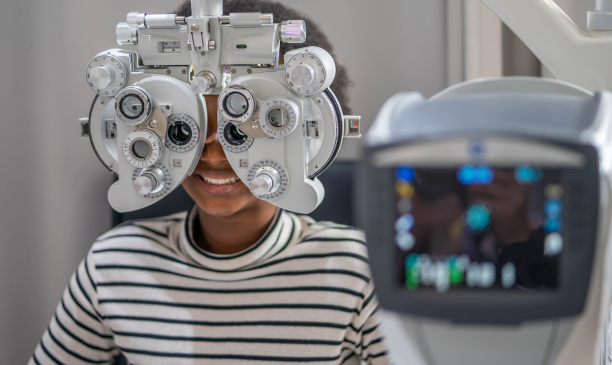Exceptional Care at Opticore Optometry: A Vision for Your Future
Exceptional Care at Opticore Optometry: A Vision for Your Future
Blog Article
The Comprehensive Eye Exam: What to Anticipate Throughout Your Visit to the Eye Doctor
A visit to the eye doctor for a detailed eye examination is greater than a regular check-up; it is a crucial step in protecting your visual health and wellness. From the preliminary discussion of your case history to the precision of the visual acuity examination, each component of the test offers a certain objective. However exactly what happens during the eye wellness analysis, and how does it influence the prescription process? Understanding these components is important for those who wish to maintain optimal sight. As we check out each element, the relevance of follow-up referrals will additionally become clear.
First Assessment
The first appointment throughout an eye exam works as an essential structure for comprehending a client's aesthetic health and wellness requirements. This stage establishes the tone for the entire assessment process, allowing the eye doctor to collect vital information about the individual's case history, way of living, and certain vision concerns. By thoroughly reviewing any kind of pre-existing problems, drugs, or previous surgical treatments, the eye care expert can customize the examination to resolve private demands properly.

Furthermore, the initial assessment is a chance for patients to articulate any kind of concerns or questions, fostering a collaborative relationship with their doctor. This interaction not only ensures that the patient feels notified and comfortable but additionally empowers them to participate proactively in their eye health and wellness administration. Jointly, these discussions make it possible for the eye doctor to create a personalized evaluation plan, guaranteeing optimum treatment and specific diagnosis.
Visual Skill Test
Kicking off the core parts of an eye exam, the visual skill examination is developed to assess the sharpness and clearness of a patient's vision. This essential analysis helps establish just how well a person can determine letters or signs at a standard distance, normally utilizing a Snellen chart (Eye Doctor). The graph consists of rows of letters that lower in dimension inside out, with the client placed at a traditional range of 20 feet
Throughout the examination, the client is asked to cover one eye and read out loud the tiniest line of letters they can see clearly. This process is duplicated for the other eye. The outcomes are taped as a portion, with 20/20 vision suggesting normal aesthetic skill-- where the person can see at 20 feet what an individual with typical vision can see at that distance.
The visual skill examination additionally determines potential refractive mistakes such as myopia, astigmatism, or hyperopia, which may demand rehabilitative lenses. By establishing a standard of visual performance, the test is an important analysis tool that helps the eye care professional in developing a proper therapy strategy customized to the client's look at this web-site one-of-a-kind aesthetic needs.
Eye Health And Wellness Analysis
Adhering to the aesthetic acuity test, a detailed eye wellness analysis is conducted to guarantee the general wellness of the eyes. This crucial sector of the eye test entails a comprehensive analysis of both the external and internal frameworks of the eye.
Through the usage of ophthalmoscopy or fundus digital photography, the retina, optic nerve, and blood vessels are diligently assessed. In many instances, student extension is done to enhance visibility of the internal eye frameworks, although this may result in short-lived light level of sensitivity for the person.
In addition, intraocular stress is gauged to screen for glaucoma threat. This is generally done making use of tonometry, which can detect elevated stress levels that might suggest possible damage to the optic nerve. Collectively, these analyses create a comprehensive evaluation to maintain ocular health.
Refraction and Prescription
Refraction is a sophisticated treatment carried out by eye treatment specialists to identify the specific lens power needed to remedy refractive mistakes such as myopia, astigmatism, hyperopia, and presbyopia. The objective of this treatment is to assess exactly how light bends as it passes through the eye, permitting the expert to establish whether corrective lenses are necessary for improved visual acuity.
Throughout the refraction procedure, the individual is asked to check out a phoropter, a gadget which contains numerous lenses. The specialist will systematically change these lenses and browse around this site ask the person to contrast clearness between alternatives till the best possible vision is achieved. This treatment is critical in crafting an exact prescription that defines the ideal lens power for glasses or call lenses.
The prescription stemmed from this treatment not only optimizes vision however also serves as a structure for choosing suitable restorative glasses. It is necessary to make sure that prescriptions are regularly updated, as modifications in vision can happen over time, highlighting the significance of routine eye evaluations. This meticulous focus to information assists maintain clear, comfortable vision in day-to-day life.
Follow-Up Referrals

Throughout a follow-up go to, the eye doctor will certainly conduct a collection of examinations to examine visual acuity and look for any type of adjustments in vision that could require an update to the prescription. Furthermore, the follow-up offers a chance to go over any discomfort or concerns experienced with existing eyewear. Modifications can be made to make certain comfort and efficiency, whether through lens modification or framework modifications.
For clients with ongoing conditions such as glaucoma, diabetes-related eye concerns, or macular deterioration, more constant follow-ups may be required. These consultations are vital for taking care of and potentially slowing the development of eye illness. Complying with these suggestions can considerably add to preserving aesthetic wellness and stopping long-lasting complications.
Conclusion
The comprehensive eye examination is a crucial procedure for keeping aesthetic health and wellness, incorporating a comprehensive evaluation of medical background and vision concerns. Secret elements consist of the aesthetic acuity examination, which evaluates vision clarity, and the eye wellness analysis, which examines the general problem of the eyes.
A see to the eye physician for an extensive eye exam is more than a regular exam; it is an important action in guarding your aesthetic wellness.Kicking off the core parts of an eye examination, the visual skill examination is made to examine the intensity and clarity of a client's vision.Complying with the aesthetic acuity examination, a thorough eye wellness analysis is carried out to ensure the total wellness of the eyes. These visits allow the eye treatment professional to check adjustments in vision, upgrade prescriptions, and analyze the total health of the eyes. Key elements include the visual skill test, which reviews vision clarity, and the eye health and wellness evaluation, which takes a look at the overall problem of the eyes.
Report this page